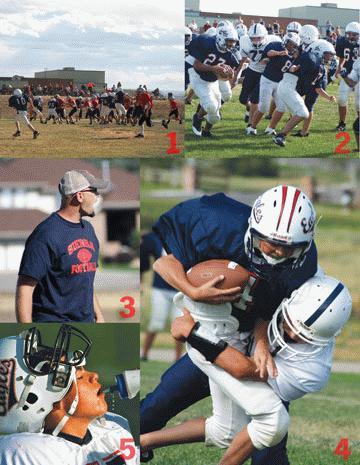Having all the images you need to tell the whole story is easy if you just think of PHOTOS in FIVE
One of the biggest challenges to a yearbook program is getting photographers ready to go at the start of the year. This is especially true for my middle school program that has a 100% staff turnover every year. It is critical to get photographers ready to cover events as quickly as possible. I use a series of short, memorable rules to make sure we get all the photos we need starting on Day 1.
The first lesson I teach is to get complete coverage of an event. A great yearbook spread can be created if you photograph the event from different levels. Our five levels of photography ensure that we have what we need. Required photos are: Scene, Group, Person, Action, Detail. For a sports event this would incorporate the field or court (scene), the fans and crowd (group), the coach (person), the highlight plays (action) and the equipment (detail). An academic shoot would include the classroom (scene), the participating students (group), the teacher or student leader (person), the event or class activity (action) and the equipment for the activity (details).
The other rule that my photographers learn early is to “shoot big.” This rule works in two ways. The first is a camera setting. Always set your camera to a high resolution and leave it. This will give you photos that you can use and crop in many ways. I also expect photographers to take lots of photos. Five to seven hundred photos from one event is reasonable. A little luck is involved in great photography. The more pictures you take, the better your “luck” will be.
Photographers will still need to learn the rules of composition. They will receive instruction on depth of field, aperture values and shutter speeds. This will take time. Teaching the five levels first will have your staff taking good photos quickly, ensuring that coverage is solid from the start.
One | SCENE
Time to shoot wide. Show the surroundings and give your reader a sense of space. This might be the stadium, the gym or the classroom. This is often the photo that is left out but will be most remembered10 years from now if you use it on a spread. You want 15% of your shots at this level.
Photo by Carter Butte
Two | GROUP
These are your storytelling shots. Use them to show interactions between people. Crowd shots during games and pep rallies work well for this level of photos. Look for a subject that stands out, but maintain the framing elements. Aim for 20% of your shots at this level.
Photo by Jasmin DeLuna
Three | PERSON
Every event is going to have an individual who stands out. This might be the coach, teacher or a student. Be sure to capture the person from head to toe. You may choose to crop the photo later, but you want options. Individual shots make great COBs. Try for 20% of your shots at this level.
Photo by Carter Butte
Four | ACTION
These are the shots that every photographer lives for. The game-winning score and the emotional reaction live here. This is where science experiments explode with color. These shots require perspective. Shoot from multiple angles and target 30% of your shots at this level.
Photo by Jasmin DeLuna
Five | DETAIL
Zoom with your lens, and with your feet. These are the often-missed photos that round out your coverage. Using light and framing are critical here. Shooting tight takes practice, but one great shot could put your spread over the top. Try to have 15% of your shots at this level.
Photo by Adam Fioretto

